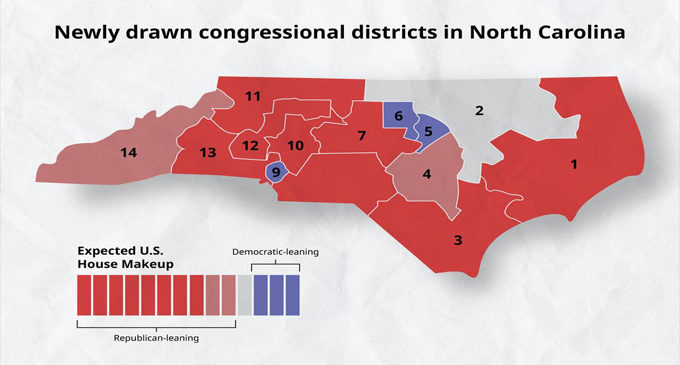Are new voting maps illegal? Courts will decide.

By Howard Pearre
If you’ve been checking your mailbox daily for your new voter registration card from the Forsyth County Board of Elections, chances are you may have to wait a while longer.
In November the legislature approved new voting maps for N.C. House, N.C. Senate, and U.S. Congressional districts including a district for an additional fourteenth U.S. Congress representative. In determining where district boundaries would be, the legislators of the majority party had the most say, and naturally, used that say to give themselves an advantage for future elections.
Some were happy with the new maps and some were not so happy, depending on which political party they affiliated with. County boards of election throughout the state began the detailed work to prepare individualized cards for every voter with information about their new voting districts and polling places.
On Monday, Dec. 6, dozens of incumbents and challengers paid filing fees, tossed their metaphorical hats into the ring, and geared up to promote themselves to voters according to the new maps handed down in November.
But then, things came to a screeching halt. Kind of.
Almost immediately, the courts put everything on hold when the North Carolina League of Conservation Voters and other individuals filed a lawsuit charging that the mapmakers had factored in partisan or racial considerations, and that the new district maps, therefore, were illegal. Some used the word “gerrymandering.”
(The term “gerrymandering” derives from a scheme developed by the Democratic-Republican Party in Massachusetts in the early 1800s in which a map was drawn with a contorted salamander-shaped voting district that benefitted that party over its opposition Federalists Party. It was signed into law by Governor Elbridge Gerry, and the Boston Globe ran a cartoon dubbing it “The Gerry-mander.” It doesn’t take a close examination of the maps the N.C. legislature produced in November to imagine a number of salamanders. The courts must decide whether or not they are legal.)
Because the lawsuit resulted in uncertainty about the new voting district lines and the voters in those districts, the state Supreme Court moved the N.C. primary date from March 8 to May 17, 2022. The court also issued a temporary order delaying when candidates could file for office, even after some already had done so. The new primary date applies to all candidates, including those who would not be affected by possible changes, such as candidates for the U.S. Senate and local offices. The state Supreme Court ordered the panel of three Superior Court judges that was hearing the case to rule on the matter by Jan. 11. This, then, will allow only several days for that ruling to be appealed to the Supreme Court, if necessary, for a final decision.
When voting district maps are finally decided, the election boards will be able to send out cards that tell voters the specific elections they will vote in and where they will go to cast ballots. The cards will include each voter’s individualized information: precinct, Congressional district, N.C. Senate district, N.C. House district, judicial districts, county commissioner district, municipality, ward, school board district, and polling place. The Forsyth County Board also plans to send out letters several weeks later to make doubly sure voters are advised about the new information.
Besides the voter cards, another way to learn this information is to look yourself up on the N.C. Board of Elections voter search webpage. Go to GOOGLE; search for NC VOTER LOOKUP; and select VOTER SEARCH. Entering only your first and last name usually will get you to the page with your information. On the next page, select your name and ENTER. The next page will give you the same information as the card. However, the information on the web page may not be accurate until the courts finalize the district lines.
Redistricting is only one type of event that generates new cards from the board of elections. The board also sends cards to voters about two weeks after they register to vote for the first time. Also, reporting a new address, change of party affiliation, or name change will generate a new card. Voters can use a Voter Registration Application form, the online Department of Motor Vehicles voter registration process, or the voter card to report these changes. The board also sends a card to any voter who has not voted in four years before it begins the process to remove the voter from the voter rolls.
So, if you’ve been holding your breath waiting for your card from the board of elections that will give you the essential information you need to plan your next voting experience, you may want to take up normal breathing for a while.










